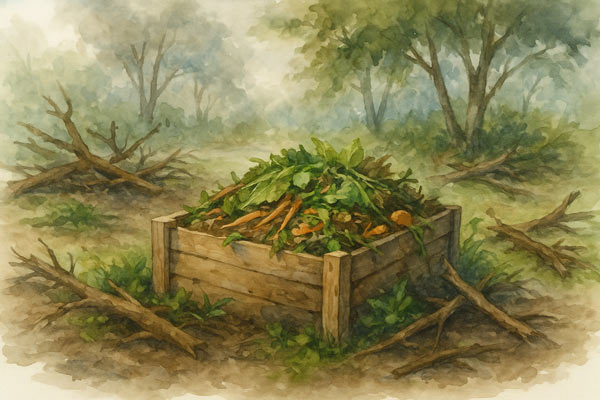 When a storm barrels through Central Florida, it often leaves behind more than flooded streets and toppled fences. It leaves a mess.
When a storm barrels through Central Florida, it often leaves behind more than flooded streets and toppled fences. It leaves a mess.
Branches. Leaves. Twigs. Weeds. Fallen fruit. Torn vines. It can feel overwhelming—but here’s the good news:
Much of that storm debris can become compost.
Instead of tossing it all to the curb, you can turn this seasonal chaos into something regenerative—rich, earthy compost that will nourish your garden for months to come.
What You Can Safely Compost After a Storm
Leaves
Dry leaves are carbon-rich “browns” that help balance your compost pile. Shred or crumble large ones for faster breakdown.
Small branches & twigs
These can be chipped, broken, or run over with a mower. Too big and they’ll take forever—but smaller pieces add structure and airflow.
Plant trimmings & vines
Only if they’re healthy. Avoid anything that looks moldy, diseased, or pest-ridden.
Fallen fruit or veggies
If it didn’t rot or ferment in the heat, toss it in! Just bury it deep in the pile to avoid attracting pests.
Weeds (without seeds)
Freshly uprooted weeds are fine if they haven’t gone to seed. Let them dry out first for best results.
What NOT to Compost
Diseased plants
Storms can accelerate mildew, rust, and fungal blights. If a plant looks sickly, dispose of it in yard waste—not your compost.
Chemically treated wood
Old lumber, painted fence posts, or treated timbers can leach harmful substances into your soil.
Pet waste or contaminated soil
Floodwaters may carry bacteria. Don’t compost anything that smells questionable or was near standing stormwater.
Palm fronds
Yes, they’re everywhere. But they’re tough, fibrous, and take ages to break down. If you must compost them, shred them first and add only a small amount.
Quick Tips to Get Your Compost Pile Going
Balance your greens and browns: Storm debris = mostly browns. Add some “greens” like kitchen scraps or grass clippings for faster decomposition.
Layer it: Think lasagna—alternate coarse branches with softer materials.
Chop or break down: Smaller pieces compost faster. Use garden shears or a small chipper if you have one.
Keep it moist but not soggy: Like a wrung-out sponge.
Turn it often: Aerate every 1–2 weeks to encourage microbial activity.
The Upside of the Aftermath
Hurricanes are disruptive. But they also prune trees, refresh the soil, and force us to slow down and reconnect with our landscape. Composting storm debris is one small way to shift from loss to regrowth.
Instead of sending your green waste to the landfill, you can return it to the earth—and watch your garden thank you.
